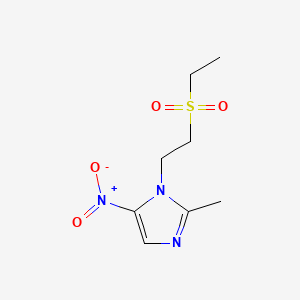Attribution Statement: LactMed is a registered trademark of the U.S. Department of Health and Human Services.
NCBI Bookshelf. A service of the National Library of Medicine, National Institutes of Health.
Drugs and Lactation Database (LactMed®) [Internet]. Bethesda (MD): National Institute of Child Health and Human Development; 2006-.
CASRN: 19387-91-8

Drug Levels and Effects
Summary of Use during Lactation
Amounts of tinidazole in milk are less than doses given to infants. Measurements of infant plasma levels during breastfeeding have not been reported. No studies have evaluated adverse effects of tinidazole on the infant during breastfeeding, but presumably they are similar to those of the closely related drug, metronidazole, such as increased risk of oral and rectal Candida infections.
As with metronidazole, concern has been raised about exposure of healthy infants to tinidazole via breastmilk,[1] because of possible mutagenicity and carcinogenicity. Opinions vary among experts on the advisability of using tinidazole during longer-term therapy while breastfeeding, but avoidance of breastfeeding for 3 days after a single dose should allow milk levels to drop to negligible values.[2] Other drugs are available for bacterial vaginosis, and can be given vaginally, which should result in lower amounts in breastmilk.
Drug Levels
Maternal Levels. Three women were given tinidazole 150 orally twice daily starting on day 4 postpartum. On day 7, milk samples were collected at 2, 5 and 9 hours after a dose. Breastmilk concentrations ranged between 5.8 and 12.7 mg/L.[3]
Twenty-four women who delivered by cesarean section were given a single intravenous dose of tinidazole 500 mg after cord clamping. Colostrum levels of tinidazole averaged 5.8 mg/L at 12 hours after the dose, 3.5 mg/L at 24 hours, 1.2 mg/L at 48 hours and 0.3 mg/L at 72 hours after the dose. The drug was barely detectable 96 hours after the dose. Only slight differences existed between concentrations in fore- and hindmilk.[4]
Five women who delivered by cesarean section were given a single intravenous dose of tinidazole 1600 mg after cord clamping. Milk concentrations and volumes were measured for 96 hours after the dose. The authors concluded that milk concentrations would be sufficiently low to commence breastfeeding 72 hours after the dose.[2]
Infant Levels. Relevant published information was not found as of the revision date.
Effects in Breastfed Infants
Relevant published information was not found as of the revision date.
Effects on Lactation and Breastmilk
Relevant published information was not found as of the revision date.
Alternate Drugs to Consider
(Anaerobic bacterial infections) Amoxicillin and Clavulanic Acid, Clindamycin, Doxycycline; (Bacterial Vaginosis) Clindamycin, Metronidazole; (Giardiasis) Metronidazole
References
- 1.
- American Academy of Pediatrics Committee on Drugs. The transfer of drugs and other chemicals into human milk. Pediatrics. 2001;108:776–89. [PubMed: 8265310]
- 2.
- Evaldson GR, Lindgren S, Nord CE, et al. Tinidazole milk excretion and pharmacokinetics in lactating women. Br J Clin Pharmacol. 1985;19:503–7. [PMC free article: PMC1463824] [PubMed: 4039599]
- 3.
- Wood BA, Faulkner JK, Monro AM. The pharmacokinetics, metabolism and tissue distribution of tinidazole. J Antimicrob Chemother. 1982;10 Suppl A:43–57. [PubMed: 7118775]
- 4.
- Männistö PT, Karhunen M, Koskela O, et al. Concentrations of tinidazole in breast milk. Acta Pharmacol Toxicol (Copenh). 1983;53:254–6. [PubMed: 6356785]
Substance Identification
Substance Name
Tinidazole
CAS Registry Number
19387-91-8
Drug Class
Breast Feeding
Anti-Infective Agents
Antibacterial Agents
Antiprotozoal Agents
Nitroimidazoles
Disclaimer: Information presented in this database is not meant as a substitute for professional judgment. You should consult your healthcare provider for breastfeeding advice related to your particular situation. The U.S. government does not warrant or assume any liability or responsibility for the accuracy or completeness of the information on this Site.
- User and Medical Advice Disclaimer
- Drugs and Lactation Database (LactMed) - Record Format
- LactMed - Database Creation and Peer Review Process
- Fact Sheet. Drugs and Lactation Database (LactMed)
- Drugs and Lactation Database (LactMed) - Glossary
- LactMed Selected References
- Drugs and Lactation Database (LactMed) - About Dietary Supplements
- Breastfeeding Links
- PMCPubMed Central citations
- PubChem SubstanceRelated PubChem Substances
- PubMedLinks to PubMed
- Review Metronidazole.[Drugs and Lactation Database (...]Review Metronidazole.. Drugs and Lactation Database (LactMed®). 2006
- Review Ornidazole.[Drugs and Lactation Database (...]Review Ornidazole.. Drugs and Lactation Database (LactMed®). 2006
- Review Secnidazole.[Drugs and Lactation Database (...]Review Secnidazole.. Drugs and Lactation Database (LactMed®). 2006
- Review Norfloxacin.[Drugs and Lactation Database (...]Review Norfloxacin.. Drugs and Lactation Database (LactMed®). 2006
- Review Etomidate.[Drugs and Lactation Database (...]Review Etomidate.. Drugs and Lactation Database (LactMed®). 2006
- Tinidazole - Drugs and Lactation Database (LactMed®)Tinidazole - Drugs and Lactation Database (LactMed®)
Your browsing activity is empty.
Activity recording is turned off.
See more...
